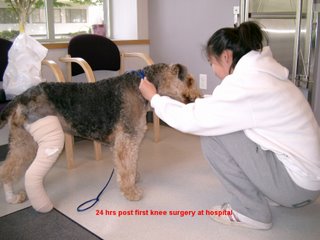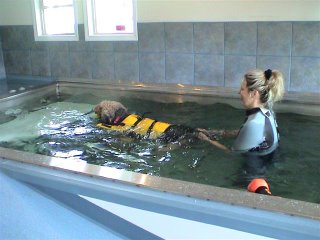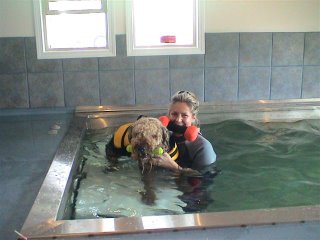My TPLO surgeries - Information on Anterior Cruciate Ligament Rupture
This is a little write up mum did on ACL tears back in Feb.2005. It talks about all the treatment options available and her experience with me.
Anterior Cruciate Ligament Rupture
How is it diagnosed?
A torn (partial or complete) ACL is often diagnosed with the palpation of the stifle for a "drawer sign" (sliding motion of the knee joint) along with x-rays. X-rays do not show torn ligaments, but it in term will show symptoms (ie, arthritis, joint effusion) associated with a torn ACL. For the muscle to be relaxed enough for a drawer sign to be detected, the dog usually has to be put under anesthetic. If a drawer sign is detectable while the dog is awake, then the chances of its being a complete rupture are high.
A torn (partial or complete) ACL is often diagnosed with the palpation of the stifle for a "drawer sign" (sliding motion of the knee joint) along with x-rays. X-rays do not show torn ligaments, but it in term will show symptoms (ie, arthritis, joint effusion) associated with a torn ACL. For the muscle to be relaxed enough for a drawer sign to be detected, the dog usually has to be put under anesthetic. If a drawer sign is detectable while the dog is awake, then the chances of its being a complete rupture are high.
MRIT aka. Traditional Repair
The Traditional surgery involves tightening of the knee joint with nylon lines or fishing lines along with the building of scar tissues to stabilize the knee joint. This type of surgery is less expensive, less invasive, takes less time to do, and can be redone if it ever fails. The down side to it is that, the nylon lines can snap, the scar tissues can break, and that means the dog would come up lame again. It also does not slow down the progression of arthritis. Here is a slide show by a rehab vet (not TPLO certified) that explains how the Traditional repair works.
Tibial Plateau Leveling Osteotomy (TPLO)
TPLO surgery on the other hand takes a lot longer to do, and is a lot more expensive since it is a patented procedure and surgeons need to be Slocum (who patented the procedure) trained, and certified to perform the procedure. You can check for surgeons who are certified to perform TPLO here:
TPLO involves cutting of the tibia, repositioning it to reduce the angle in the stifle to between 0-6 degrees (normally between 15-40degrees). By doing so, the need for the ligament is eliminated since the tibia and the fibula would not be sliding pass one another. Here is a detailed explanation with illustrations on the mechanics behind the TPLO procedure (click on Procedures on the right to learn more about TPLO):
With the TPLO, the dog can bare weight faster than the Traditional repair. It has a low failure rate and arthritis tend to set in at a slower rate compared to the Traditional repair. But there are dark sides to this seemingly so perfect surgery:
1. If something goes wrong, it goes very wrong, and most of the time, it will need additional surgeries to fix the problem. So the experience of the surgeon is key to this type of surgery.
2. Any metallic implant has the potential to cause bone cancer in humans and animals. And there is a plate and 6 screws used in this surgery to hold the repositioned tibia in place until the bone heals. However, plate & screw removal is always an option.
Here is an abstract of a medical journal published by four surgeons, including Dr. K Sinibaldi, the experienced surgeon who operated on my Sunshade:
Recovery Period
The recovery period for both types of surgery is about the same: the first 6-8 weeks of confinement, followed by another 6-8 weeks of slowly building up the normal activity level. With the Traditional repair, you want the scar tissues to build up and be strong enough to hold the nylon lines in place. With the TPLO, you want the bone to heal.
Conservative Management
Conservative management is always an option for a strained or partially torn cruciate, or if surgery is not an option. Conservative management includes: physical therapy (hot/cold packs, electric muscle stimulation, ultrasound, treadmill, underwater tread mill, swim therapy), acupuncture, knee brace (http://www.woundwear.com/product3.cfm), and supplements.
There is a group on Yahoo that deals with that specifically:
1. If something goes wrong, it goes very wrong, and most of the time, it will need additional surgeries to fix the problem. So the experience of the surgeon is key to this type of surgery.
2. Any metallic implant has the potential to cause bone cancer in humans and animals. And there is a plate and 6 screws used in this surgery to hold the repositioned tibia in place until the bone heals. However, plate & screw removal is always an option.
Here is an abstract of a medical journal published by four surgeons, including Dr. K Sinibaldi, the experienced surgeon who operated on my Sunshade:
Recovery Period
The recovery period for both types of surgery is about the same: the first 6-8 weeks of confinement, followed by another 6-8 weeks of slowly building up the normal activity level. With the Traditional repair, you want the scar tissues to build up and be strong enough to hold the nylon lines in place. With the TPLO, you want the bone to heal.
Conservative Management
Conservative management is always an option for a strained or partially torn cruciate, or if surgery is not an option. Conservative management includes: physical therapy (hot/cold packs, electric muscle stimulation, ultrasound, treadmill, underwater tread mill, swim therapy), acupuncture, knee brace (http://www.woundwear.com/product3.cfm), and supplements.
There is a group on Yahoo that deals with that specifically:
Paola Ferraris on there is very knowledgeable. Her yellow lab had one TPLO and one Traditional repair.
The Yahoo Orthodogs group is also a good place to get information and advice. 80% of the people on the list have either dealt with or are dealing with torn ACL’s. Paola is also on this list.
The Yahoo Orthodogs group is also a good place to get information and advice. 80% of the people on the list have either dealt with or are dealing with torn ACL’s. Paola is also on this list.
http://groups.yahoo.com/group/orthodogs/
Our Story
My 5 year old girl (60 lbs), Sunshade, had 2 TPLO's done back in 2003. To make a long story short, in Feb of 2003 I noticed that she was starting to have intermittent lameness in her right hind leg after exercise. Took her to the vet for x-rays. The x-rays showed mild joint effusion, no arthritis, a strained or partially torned cruciate was suspected. My vet put her on Ligaplex I (acute cruciate damage at the time, was later switched to Ligaplex II as it was chronic by then) along with other joint supplements. We started conservative management with her in the hopes that scar tissues would build up to stabilize the joint and no surgeries would be needed. The CM went really well and the intermittent lameness went away........Until one day, while she was in the yard, a DAMN squirrel decided that he wanted to run along the top of my fence. And that was it, her ACL was completely ruptured. Surgery was Sunshade's only hope for "quality" of life since she lived for her beach walks. So in May of 2003, she had her first TPLO, and her second in December of 2003.
I was torn between the two kinds of surgeries: Traditional vs. TPLO. I hated the idea of fracturing a leg for a torn ligament, and yet at the same time, I wanted Sunshade to live as long of a pain free life as possible, which to me, meant less arthritis and no lameness after exercise. I took her to see 3 surgeons (one who did the Traditional Repairs, the other 2 were certified TPLO surgeons) and got all their opinions.
It took me a long time to decide which type of surgery to have it done on Sunshade, but I ultimately decided on the TPLO due to the following factors: she was young, active, and has had arthritis in one of her elbows ever since she was 18 months old. I felt that the TPLO procedure would put less stress to her arthritic elbow since she would be able to weight bear sooner (which she did at 24 hrs post-op). Also, knowing the way my girl played (sudden stops, fast turns, no regards for her body whatsoever), I felt the chance of her tearing the Traditional repair was very high. I didn't think either of us could endure 2 surgeries/recoveries on the same leg. This is how I came to my decision.
Sunshade was using her surgery leg both times at only 24 hrs post-op. She was able to walk without a limp at only 2 week post-op, and trotted without a limp at 4 weeks post-op. She was confined to an x-pen up until her bone was pronounced being completely healed. I covered the slippery floor with runners to prevent slipping, and made a ramp over the stairs down to the yard. I moved the mattress down to the floor at night so that I didn't have to worry about her jumping up and down from the bed.
We were lucky enough to have a rehab vet in the area, so we started physical therapy with Sunshade right from the beginning, which resulted in limited muscle loss and fast recoveries.
As of today, I am very glad that I chose the TPLO procedure because Sunshade is simply doing FANTABULOUS!!! Her x-rays showed at 1 year & 1.5 yr post op, there is still no signs of arthritis. I did, however, had her plates and screws removed from both of her knees as the thought of Osteosarcoma just freaked me out.
Sunshade's surgeries were done in Seattle, WA and it was $3000 US for her first knee, $3500 US for the second knee (had the plate and screws from the first TPLO removed at the same time).
Here is a picture of Sunshade doing hydrotherapy at 8 weeks post her first TPLO. Scroll down, you will see her little cousin having his first swim lesson at 10 weeks of age.
As of today, I am very glad that I chose the TPLO procedure because Sunshade is simply doing FANTABULOUS!!! Her x-rays showed at 1 year & 1.5 yr post op, there is still no signs of arthritis. I did, however, had her plates and screws removed from both of her knees as the thought of Osteosarcoma just freaked me out.
Sunshade's surgeries were done in Seattle, WA and it was $3000 US for her first knee, $3500 US for the second knee (had the plate and screws from the first TPLO removed at the same time).
Here is a picture of Sunshade doing hydrotherapy at 8 weeks post her first TPLO. Scroll down, you will see her little cousin having his first swim lesson at 10 weeks of age.

1 day post TPLO surgery #1 - mum came to visit me at the hospital (05/07/03)

I was so brave and was already using my surgery leg (05/07/03)

Me doing rehab with my therapist Barb - 8 weeks post TPLO #1

Therapy with Barb

Look at us having so much fun!!! Because I was recovering from surgery, I couldn't be groomed, so.....I looked like a woolly mammoth!
Last note, it is a very good idea to be on a monthly pet insurance plan BEFORE any health issue arises. It will save you lots of money should something unexpected happens, like a torn cruciate ligament.











2 comments:
Hello Sunshade and Sunshade's Mom,
I am Little Bear's Mom and she has a ruptured CCL and perhaps a damaged meniscus. She injured it leaping to catch a ball after having injured it earlier in the year. Now I am in the process of choosing her treatment.
Your site is wonderful in so many ways. One is all the information that you have provided about TPLO.
Question #1: How was the 2nd plate removed and the cost? (There is an abstract at http://avmajournals.avma.org/doi/abs/10.2460/ajvr.67.7.1258 about research done to "determine the material properties of the TPLO plates and assess the soft tissue reaction adjacent to these plates in dogs that had undergone tibial plateau leveling osteotomy (TPLO)" with the following conclusions: "Results determined that new and retrieved TPLO plates were manufactured from 316L stainless steel and produced by a casting process, but not all plates met specifications for chemical composition of cast surgical implants (American Society for Testing Materials standard F745); tissues surrounding retrieved plates had evidence of adverse reactions, probably as a result of plate corrosion." So you probably made a wise choice in having the plates removed.)
Question #2: Was the 2nd surgery on the other side also to the ACL?
Thanks for all the info and for the great stories about Sunshade and you. Your devotion to each other is inspiring.
XOXO, Jill
jillb44@yahoo.com
I am glad you had a good experience with TPLO, I have not always heard the best of outcomes with this procedure. We opted to go with a traditional repair for our boy, Tucker, and he has also done great. Here is another good site for anyone looking for information about CCL repairs - http://dogkneeinjury.com
Post a Comment